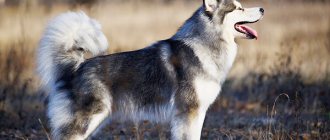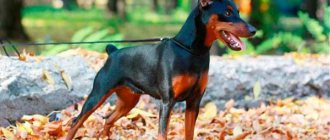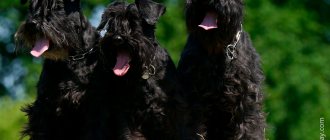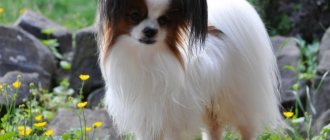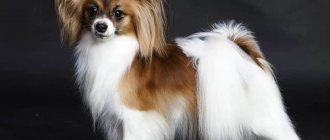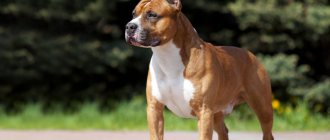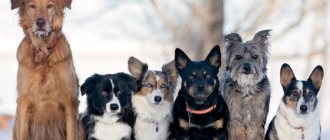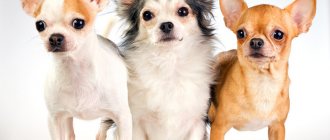Laika is the general name for hunting dog breeds common in the northern forest areas of Asia, Europe and North America. All representatives of this species belong to the Spitz group. The main purpose is game hunting. The animal delays the overtaken beast with a loud, incessant bark. Hence the name of the breed – Laika.
Sled dogs are often included in this group, which include huskies, Samoyeds, Kimmicks, etc. The article presents all breeds of Laikas with photos and names. A brief description of each type separately is also given.
History of the origin of the species
This breed is considered native for a reason. Dogs have lived near humans for thousands of years. Perhaps these animals are the closest relatives of domesticated wolves and jackals. The first evidence of the existence of Laikas is found on the territory of ancient Rus'. The oldest fresco depicting furry pets dates back to the 11th century.
Read the detailed article: “How to distinguish a Laika from a Husky: characteristics of the breeds.”
These animals not only served the northern peoples, but also helped the Western European nobility in hunting. Rich people loved to go into the forests to hunt bears and wild boars; Laika coped with their baiting remarkably well. An interesting fact is that all representatives of this group are called Spitz abroad.
Selection and mixing of blood in the north was not particularly followed. Working qualities were distributed equally across all newly emerging breeds . The official description of these animals appeared only in the 19th century. Just at this time, work begins on classifying and improving the qualities of the breed. The participation of Prince Shirinsky-Shikhmatov and dog handlers: Poplavsky and Dmitrieva-Sulima is considered important.
There are 3 main types of Laikas: sledding, herding and hunting:
- The first group is considered the most numerous, in terms of the number of species included in it. This includes draft dogs, which are especially popular in the north.
- The second subspecies includes those Laikas who protect livestock from wolves and bears.
- Hunting dogs still perform their functions and are considered indispensable in northern European regions.
Hygiene
The West Siberian Laika is an unpretentious working dog and there is no point in traveling with it to grooming salons. Yes, during the molting period (autumn-spring), the ZSL’s fur will have to be combed with a sparse comb, sometimes using a furminator, but otherwise not much time is spent on caring for and creating the image of the pet. Laikas are rarely washed: mainly before exhibitions or when the animal is thoroughly dirty. Moreover, in the summer, occasional swimming in open waters will be enough.
Working and well-walked dogs do not need to have their nails trimmed at all. For individuals that are not particularly active, the plate is trimmed once a month with a nail clipper for large breeds. At the same time, it is better to examine the eyes and ears of the inhabitants of enclosures daily, so as not to miss or cause inflammation. One of the main working “tools” of the West Siberian Laika is its paws; accordingly, after hunting and walking, they should be given increased attention. Minor cuts, scratches, and other injuries should be treated immediately with veterinary ointments or creams. A good help would be vegetable oils, which are used to lubricate the paw pads to prevent the appearance of cracks and peeling on them.
East Siberian Laika
This breed is a hunting breed, it is multifunctional: it is capable of hunting both squirrels and deer. It is distinguished by a large, strong body; it is the largest among its brothers, reaching 53-65 cm . Hardened by frosts and the north, tireless in work. Like all Laikas, the breed belongs to the 5th group and 2nd section: Spitz and primitive type breeds, northern hunting dogs. Homeland - Russia. The dog was officially registered in 1949.
The animal has an elongated format, although most of its brethren are square. Strong paws, bones, and head help the dog survive in low temperatures, squally winds and hard work. The standard describes the following external characteristics of all huskies:
- The head is wide, massive, wedge-shaped with pronounced cheekbones;
- The muzzle is equal in length to the head, well filled, with strong jaws and a scissor bite;
- The eyes are medium-sized, oval, slanted, brown in color;
- The nose is large and fleshy, always black;
- The ears are erect, triangular, with a medium set;
- The body is long, muscular, with a straight top line, a tucked bottom line, pronounced withers, and an oval loin; The neck is long (equal to the length of the head);
- The tail is long, curved and carried over the back;
- The limbs are long, straight, parallel, with oval, collected paws;
- The coat is medium length, hard, straight, with a soft undercoat;
- Colors: black, white, piebald, black and tan, red, gray, brown.
For this breed, it is preferable to be kept in an enclosure or outdoors; if the range is free, then the animal should be on a soft long chain (prone to escape). The main criterion for proper care is long active walks and hunting. It is best to use such a pet for its intended purpose; it will not become a sofa pet.
A distinctive feature is thrifty eating habits. East Siberian huskies can eat to their heart's content because they are worried about the future feeding regime. This is convenient for avid hunters who can go into the forest for 2-3 days. Under normal conditions, this habit can cause the development of diseases.
The cost of the rare Siberian breed may surprise you because it is significantly lower than other exotic dogs. Without a pedigree, a puppy will cost 7,000-10,000 rubles , a pet-class or breeding class - 15,000 rubles , a show class - from 20,000 rubles . It is worth noting that the price for adult Laikas depends on their working qualities. A dog that hunts large animals will cost more than one that hunts small fur.
Breed standard
Each type of husky has its own breed standards. Here we will talk about what parameters the West Siberian variety should have. You can get acquainted with them in the table.
Breed standard and deviations
| Standard name | Norm (for males and females) | Vice |
| Dimensions | Males height at withers 55 – 62 cm Bitches height at withers 51-58 cm | Any deviation up or down |
| Suit | White, zone, gray, red, brown (any shade). White coat color allows for a brown nose | Black, black with white (not zonal), the appearance of specks on the body, head, paws does not match the main color.* |
| Wool | The guard hairs are straight and hard, there is an undercoat that is well developed and is soft and fluffy. | The presence of wavy and curly hair, excessive length, the presence of camber on the back, as well as dewlap on the tail.** |
| Skin, muscles, bones | The skin is dense, elastic, the muscles are well developed, the bones are strong | Any deviation from the norm |
| Head | It is wedge-shaped, the skull is moderately wide, the forehead meets the muzzle without sharpness, the muzzle should be sharp, long, but not narrow. Lips fit tightly, there are no drooping or jowls | The presence of a head of a raw and heavy type, there is a sharp steep transition from the frontal lobe to the muzzle, the muzzle itself is short and upturned |
| Ears | They have a high stance and the shape of elongated triangles, stand straight, the lobe is weakly defined | The presence of a round top, prominent earlobe*** |
| Eyes | Small in size, almond-shaped, dark brown or hazel in color, eyelids have a sharply oblique cut | Round eye shape, straight eyelids, color other than brown (white, yellow, green, etc.) heterochromia |
| Teeth, bite | White in color, large in size, should fit tightly to each other. Scissor bite | Deviation from the general provisions of the breed standard |
| Hind limbs | Good muscularity, good definition of angular articulations when viewed from the side | Pronounced straight rear, excessive closeness or spread of the hocks |
| Forelegs | Moderately oblique shoulder position, good muscularity, | Pronounced size, presence of clubfoot, straight shoulders |
| Tail | Bend into a steep ring on the back or side. It can be sickle-shaped, but it must touch the back. Straight reaches the hock joints or be 1-2 cm smaller, but not shorter | Tail shaped like a rod, plume or saber |
*huskies with brown and brindle colors are considered out of breed;
** Short-haired and long-haired dogs are considered out-of-breed;
*** the presence of drooping, semi-erect ears with drooping tops makes the dog out of breed.
Russian-European
A hunting dog of a square format with a lean, muscular build. In height, males reach 52-58 cm, and females 50-56 cm. Representatives of the breed weigh 18-25 kg . A distinctive feature is black and white or pure black colors. Outwardly, the most sophisticated and graceful Laika. They hunt any game, but require some preparation. They can serve as guards.
The USSR (Russia) is considered the birthplace of the breed. The breed has been recognized since 1980. Belongs to the 5th group and the second section.
Unpretentious pets that can adapt to life in a city apartment. The best option would be an enclosure. Animals need to move a lot and actively, hunt, run. It is necessary to provide the dog with proper physical activity.
The cost of Russian-European Laikas depends on their pedigree and working qualities. For a middle-class pet you will have to pay from 15 to 20 thousand rubles. If the dog is mature and trained, the price increases.
Health
The West Siberian Laika is an exceptionally healthy breed. She is genetically pure, without hereditary defects, and not susceptible to injury. All pathologies in dogs appear due to negligence or poor care.
When people say that their wounds “heal like dogs,” they mean West Siberian Laikas. Dogs easily endure severe injuries, and minor injuries heal within a few days.
Huskies live on average 12 years. But some dogs lived up to their 16th birthday.
Preventive measures
No matter how healthy the breed is, preventive measures are mandatory. Since the West Siberian Laika is often found in the forest and comes into contact with wild animals, you need to:
- treat the fur coat from blood-sucking parasites;
- from spring to autumn, use a collar against fleas, ticks, and lice;
- give deworming medications monthly;
- Be sure to vaccinate against rabies and canine distemper.
Of the remaining vaccines, serums are recommended for herpes, parvovirus, parainfluenza, adenovirus, leptospirosis, and hepatitis.
Development by months
ZSL puppies grow quickly. In just a year they reach the size of an adult dog. Therefore, the first 12 months are critical. At this time, it is necessary to monitor the height and weight of the dogs, make sure that they gain sufficient weight, but do not overeat.
The size of the puppies depends on their age. The table will help you navigate. If in doubt, you can look at the photos - they show what healthy, moderately well-fed kittens look like.
| Month | Males (weight in kg) | Bitches (weight in kg) | Males (height in cm) | Females (height in cm) |
| 1 | 2,25 | 2,05 | 29 | 25 |
| 2 | 5,5 | 4,5 | 37 | 34 |
| 3 | 8,7 | 7,5 | 43 | 40 |
| 4 | 11,4 | 10 | 48 | 46 |
| 5 | 15,2 | 13,2 | 53 | 50 |
| 6 | 16,2 | 15,3 | 56 | 53 |
| 7 | 17 | 16,2 | 58 | 54 |
| 8 | 18,9 | 17 | 59 | 55 |
| 9 | 19,9 | 19 | 60 | 55 |
| 10 | 20 | 19,5 | 60 | 56 |
| 11 | 20,8 | The weight of an adult husky does not change | 60 | 56 |
| 12 | 21,2 | 61 | 57 |
Average values are shown. The upper and lower limits of the norm vary - +/- 2 cm of height and 0.5-1 kg of weight are acceptable.
Karelo-Finnish
A breed bred in Russia, more specifically, in Karelia. Adapted for hunting birds, furs, and small ungulates. Previously, the standard separated Karelo-Finnish Laikas and Finnish Spitz. Now these dogs are considered one breed line.
Recognized since 1935 by the International Canine Organization, they belong to the 5th group and 2nd section. Since 2006, 2 livestock have been indicated: Russian and Finnish.
The dog is of a square format, the shortest among all its brothers: at the withers, representatives reach 42-50 cm , weigh about 7-12 kg . A special difference is the juicy red-red color .
Like all huskies, Karelians love freedom and space. They can live in an apartment due to their small size, but it is better to provide them with an enclosure or yard. The area must be fenced. These huskies do not tolerate hot weather well, so it is better to breed them in a temperate climate. Dogs need proper coat care.
Read a detailed article about the breed: “Karelo-Finnish Laika (Karelka) is a Russian hunting breed.”
These animals can be considered one of the most expensive among their brethren. But it is possible to find a puppy without a pedigree for 5-10 thousand rubles . Dogs with status will cost 15-70 thousand rubles .
Mating
West Siberian huskies mature early. Estrus (first heat) occurs from six months to a year. But dogs are not bred that early. The optimal start for mating is from 15 months for males, from 18 months for females.
Only healthy, purebred dogs are allowed for breeding. The rest are discarded.
Pregnancy lasts 53-71 days and is easy. Dogs give birth on their own; caesarean sections are rarely performed. There are an average of 4-5 puppies in a litter.
West Siberian
This breed is the most numerous, in terms of the number of heads, and the most common among hunters. It is distinguished by its predatory appearance; it is more like a wolf in color and temperament than others. Not large in size - 52-60 cm at the withers, with a weight of 16-22 kg . Externally a strong animal, elongated format. It is considered a universal hunting dog.
Country of origin: USSR (Russia). The breed received recognition in 1980 and is officially registered by the International Canine Organization.
In proportions and appearance it is not much different from the East Siberian. A special feature can be considered deep-set, sharply slanted eyes and a predatory gaze. Preferred colors : white, piebald, brown, gray, red.
The breed does not cause any difficulties in caring for. West Siberian huskies are unpretentious. They can go for a long time without water and food, work hard, and hunt. Such dogs need space; living in an apartment will negatively affect their well-being. In order for a pet to live on the street, it needs to be equipped with an enclosure or a booth with a soft chain. It is important to regularly go hunting with your animal or just for walks in the forest.
Read a detailed article about the breed: “The West Siberian Laika is an excellent hunter and a cheerful companion.”
A puppy without a pedigree can be purchased for 3,000-5,000 rubles , a pet-class or breed-class for 15,000-20,000 rubles , a show class dog for 25,000 rubles .
At what age are puppies trained to hunt?
You need to work with a puppy from the moment it arrives in the family. Initially, basic skills are trained:
- remembering nicknames;
- training to use a collar, leash, harness;
- mastering the “Nearby” command;
- approach not only by command, but also by whistle;
- teaching the commands “Sit” and “Lie down”;
- carrying objects, and the puppy must wait for the owner to pick up what he brought;
- accustoming to bodies of water (only during play, the puppy must go into the water on its own, and not under the owner’s coercion).
Subsequent sessions with the puppy must be moved to nature so that the pet gets accustomed to the environment and is not distracted by outside sounds and smells during the training process.
Yakutskaya
Yakut Laikas, although considered universal, are most suitable as sled dogs. Their standard was published in 1959, but the breed is still not recognized by the World Canine Organization. Conventionally, it belongs to the 5th group and 2nd section. The dogs were bred and described on the territory of the USSR, in Yakutia, where the name came from.
The peculiarity of the breed is considered to be its interesting black and white color, light blue eyes and abundant fluffy hair . These dogs are compact, reaching 53-59 cm at the withers. The format is square.
These dogs are unpretentious and require the same care as all huskies. They eat little, but can work for a long time and survive frosts and winds. They don't like heat. Best kept in an enclosure or yard in a temperate climate. Standard coat care is required: brushing, bathing (2-3 times a year).
You can buy a puppy without a pedigree for 7,000-10,000 rubles . A pet with a certain class and working properties will cost 10,000-30,000 rubles .
Owner reviews
Most owners praise their pets very much, but do not forget to mention that the dogs are very energetic and therefore need long walks. Some people talk about the willful nature of huskies, which is not so easy to deal with. Still others say that a number of problems are caused by caring for a pet during shedding.
As a conclusion, I would like to remind potential owners that huskies are dogs that need to be constantly exercised. These are working dogs, not fluffy pet toys; if you do not load your pet with the loads it needs, then it will find entertainment for itself, which the owner may not like at all.
Karelian Bear
An ancient Finnish breed, which, as the name suggests, is used for bear hunting. Very similar in appearance to the Russian-European Laika, has the same color, build and coat length. The dog is small in size - 52-57 cm at the withers, 1 7-27 kg in weight. The body is elongated, lightweight, elegant.
The breeding and restoration of the breed began in 1936, the standard was written in 1945. Like other huskies, these are classified as the fifth group and the second section.
Like most Laikas, Karelkas have a long wedge-shaped skull , an elongated dry body , straight paws a tail thrown into a ring . The color can be white or black with large spots.
These huskies can live in apartment conditions, but the best option, of course, would be a country house with a fenced area. The climate is needed to be cold or temperate, because heat, like its counterparts, is destructive. The wool is regularly combed and water hygiene procedures are carried out a couple of times a year.
60,000-80,000 rubles for a purebred representative . Without a pedigree, puppies cost about 15,000-20,000 rubles .
Vaccinations and susceptibility to disease
Like all dogs, Laika puppies receive their first vaccinations in the first year of life, but vaccinations are not carried out during the change of teeth.
| Age | From what disease | Note |
| 8-12 weeks | Distemper, infectious hepatitis, leptospirosis, parvovirus enteritis | Primary vaccination |
| 11-15 weeks | Similar list | Revaccination (repeated vaccinations) |
| 9-12 months | Parvovirus enteritis, rabies | Last vaccination, then repeated a year later |
Laika bears puppies from 55 to 65 days, it depends on the number of puppies in the litter. If labor has not started before 70 days, then urgently take the dog to the veterinarian. Laika is a hunting breed that can become infected when bitten by a pursued weasel or marten, while in a forest pond, or attacked by a snake. Therefore, if there is a sharp increase in temperature and low mobility of the dog, you should urgently contact a veterinarian.
Lifespan
This breed is distinguished by its exceptional love of constant movement. If you keep your pet busy with running, active games and weekly hunting trips, the husky will live a full life, delighting the owner with its activity in pursuing any animal. The age limit for this breed is 12-14 years.
Norwegian
This breed has several names: Norwegian Laika, Moose Laika, Norwegian Elkhound. Dogs are indeed still used to hunt moose. They were developed in Scandinavia in 1877, which is the official date of recognition of the standard. It is believed that this is one of the most ancient Norwegian breeds.
There are two varieties: black and gray Elkhound. They differ only in color. Their format is extended. The body is dry, muscular, strong. The animals are smaller in size than their counterparts: 49-52 cm at the withers. They weigh 15-25 kg .
The Norwegian Husky is also called the Buhunda. It differs from its brother in functions: it has a guard shepherd function and is considered a farm dog. These dogs also have light red and wheaten colors. In all other respects the breeds are similar.
Caring for these Laikas is standard : regular brushing, twice a day bathing (per year), active long walks. Suitable only for outdoor and aviary keeping; they do not tolerate heat.
A purebred puppy with all documents can be purchased for 20,000-40,000 rubles . Without a pedigree, a dog will cost less - up to 10,000 rubles .
We also recommend that you read the article: “White, fluffy bundle of happiness – Samoyed dog (Laika).”
Diseases
Laikas are distinguished by good health. This is due to the careful selection, because only physically strong dogs can benefit the hunter.
Among the most common diseases in huskies are:
- diabetes;
- renal failure;
- deafness
- glaucoma
- retinal atrophy;
- bloating;
- hip dysplasia.
Features of keeping and caring for Laika
All Laikas are active, energetic, and need a lot of space. Apartment housing is only suitable for small breeds, but this is only possible with long walks and training. These dogs get along best in a free enclosure or in a fenced local area.
It is important to choose the right climate. These animals are not afraid of frosts and blizzards, but the heat can be destructive. Therefore, in warm southern countries it is not recommended to have Laikas.
In general, the breed is unpretentious. Laikas are omnivores and do not require constant attention and care. Dogs are original, they are used to working for long periods of time, going hungry, and looking for food on their own. But to improve the pet’s quality of life, it is worth following the feeding regimen, vaccination and walking schedule.
You need to purchase a comfortable lounger or mattress, and equip an enclosure or booth. Usually Laika is kept on a soft long chain. There must be a canopy where the animal can shelter from bad weather.
Important article on the topic: “Everything you need to know about dog vaccinations.”
Features of character and behavior
All Laek representatives are similar in character. These are freedom-loving northern dogs who are accustomed to serving people faithfully. They are all good hunters, have enough strength, endurance, a sharp mind and training abilities.
But the negative traits of the breeds are also similar. In most cases, they manifest themselves in stubbornness and a desire for dominance.
Advantages and disadvantages
- First of all, the breeds are valued for their amazing physical capabilities . Any husky can be considered a first-class athlete and hunter. They have developed sense of smell, hearing and vision; high survival rate, resistance to cold climates, and performance are noted. In addition, dogs are considered healthy and have strong immunity.
- These animals are balanced, calm, and friendly, which is why they often cannot serve as guards . They are used to living side by side with humans, so they do not experience aggression or anger. They get along easily with children and love to play with them.
- Excellent training acquisition rates . Laikas are very smart, quickly grasp, and easily cope with commands. They are active and energetic, quickly master agility, love to run with their owner and play sports.
Among the shortcomings of the breed are stubbornness, love of freedom, and often disobedience. Without proper training, a dog can become uncontrollable.
Laikas love to chew and damage furniture and household items. They are in dire need of physical activity, although otherwise they are unpretentious.
Nutrition
Laikas are completely unpretentious. They are not gluttonous and can go without food for a long time. Adult pets are usually fed 2 times a day, puppies - 4-5 times . The serving size depends on the activity of the animal. Street dogs need more food. The portion is also increased in the cold season.
Like all pets, Laika can be fed with both dry and natural food. If the owner chooses the first option, then grain-free products for medium active breeds with a high protein content are suitable.
We recommend that you read a detailed article on the topic: “How and what to feed a dog: types and characteristics of nutrition.”
Natural nutrition should consist of 50% protein foods:
- Meat;
- Boiled sea fish without bones;
- Dairy products;
- Eggs.
The pet also needs cereals: cereals boiled in broth or water. From puppyhood, the animal should be given vegetables and fruits low in starch.
Dogs should not be fed from the owner's table, nor should they be given bones, flour and confectionery products, fatty, fried, salted and smoked foods.
Walk
These dogs, like no other, need active long walks and training.
- Even if an animal is kept in an enclosure or on the street, it needs to go out into plantings, forests, and park areas to run around, burn off energy, and hunt.
- The best pastime for Laikas is what is provided genetically: for sled dogs - running in a harness, for shepherds - grazing livestock, for hunters - hunting.
- It is recommended to keep these dogs on a leash at all times, especially in crowded places. Due to their strong instincts, they are prone to running after game, cats and small rodents.
- Apartment pets need regular walks two or three times a day for 1.5-2 hours. At first, puppies are walked more often, but for 30-40 minutes.
Grooming
- coat care is needed, especially during seasonal shedding. brush your dog 2-3 times a week using slicker brushes and long-toothed brushes.
- are bathed 2-3 times a year; they can be wiped with snow or watered with a hose.
- In the summer, Laikas are cut , but this procedure is contraindicated for show animals.
- Ears, eyes and teeth are examined every week. Clean when dirty.
- The claws of these pets grind down without human intervention, but if they grow too long, they can be trimmed with a nail clipper.
During the summer, pets need to be treated for fleas and ticks. Also, do not forget about deworming (cleansing from worms), which is carried out once every 2 months.
Training
The character of Laikas can be complex, it is very difficult to curb their temperament, so not everyone can cope with upbringing and training. Such a dog can only be entrusted to a professional or experienced hunter. In order for a husky to obey, the owner must be strict and firm. But respect for your pet is the key to a long, good relationship. The pet will not tolerate rough treatment or insults.
By 3-4 months, the puppy should know its daily routine, nickname and primary rules of behavior . Socialization can begin after the second vaccination. This is important so that the dog learns to control its emotions and respect other people and pets.
Read about how to properly train a dog in the article: “Training a puppy: effective methods from dog handlers, learning commands at home.”
To adapt to hunting, animals must be sent to special canine institutions, or allowed to be handled by specially trained people.
All groups of Laikas and individual breeds are similar in appearance and temperament. You can choose a specific one based on function, color or size. In general, all species are friendly, active, loyal and good hunters.
3.3 / 5 ( 420 votes)
Interesting facts from the life of sled dogs
Connoisseurs of sled dog breeds are ready to talk about them for hours. Turns out:
- People began using dog sleds as a form of transport about 8,000 years ago. This is confirmed by artifacts discovered on the New Siberian Islands.
- Quadrupeds took a direct part in many geographical discoveries. For example, the discoverers reached both poles of the earth using dog sleds.
- Sled dogs are capable of trotting up to 80 km per day.
- Laziness in the dog “team” is punishable. The shaggy draft horses control each other. If someone has a desire to cheat and literally dump their work on the paws of a neighbor, he gets a lot of punishment from the leader - the educational process begins as soon as the owner releases the dogs from the harness.
It is the leader of the pack who reacts to the owner’s commands and sets the pace of movement for the entire team.
- To control sled dogs, reins and strict whips are not required; the dogs only need voice instructions. Violence is unacceptable here. However, in order to gain the authority of the pets and their absolute obedience, the musher has to devote a lot of time and attention to them.
- In addition to a delicious dinner, dogs consider their owner’s praise as a reward for their efforts. That is why a competent musher, when stopping, goes around his “subordinates” and praises each one: he will lightly scratch one behind the ear, gently pat another by the furry withers, stroke the third on the head and encourage him with words. No one should be left unattended or, conversely, become one of the favorites! Dogs notice everything, get jealous and are very offended. Deprived of their master's love, pets can seriously abuse their favorite.
To ensure that the team covers the maximum possible distance and the “horses” do not get tired quickly, the mushers maintain a speed of no higher than 12 km/h.
Photo
In this article you got acquainted with the amazing Laika breed, photos of which are presented in the gallery above. A hardy hunter, a devoted friend and companion, this dog is able to grace any owner with its daily presence.
